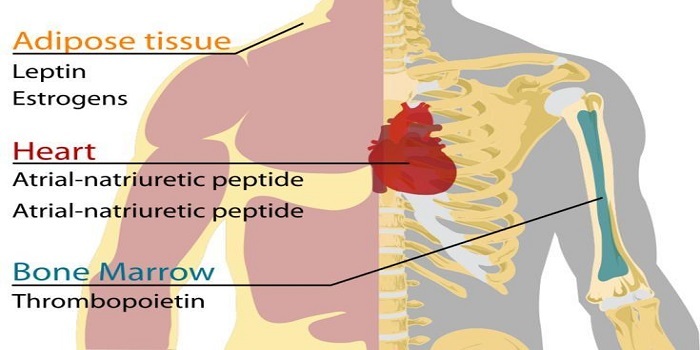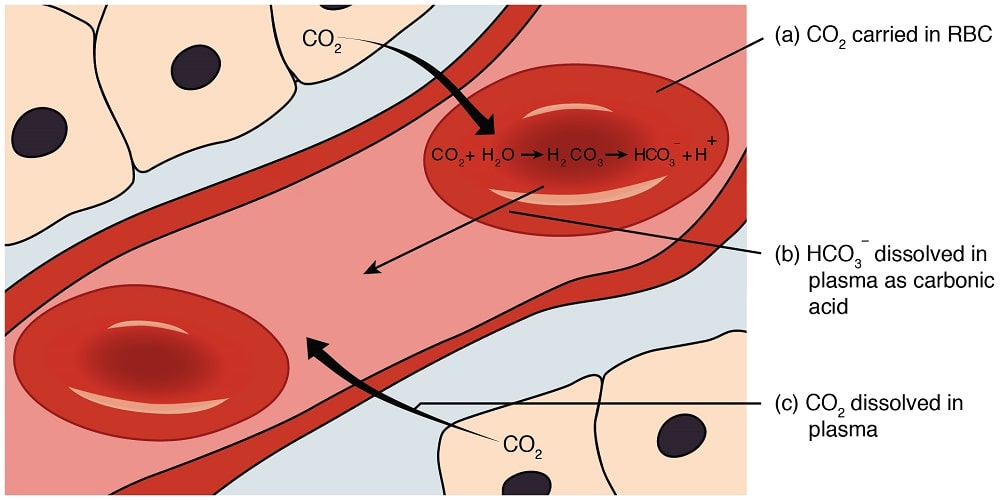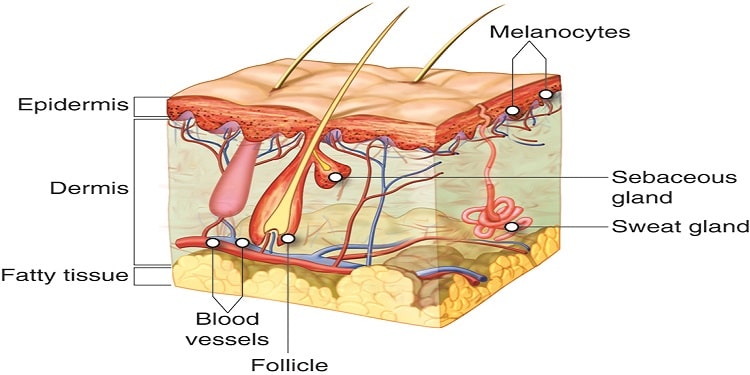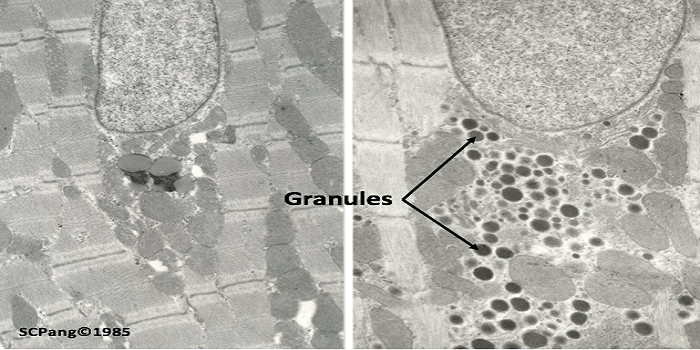Atrial natriuretic peptide (ANP) a natriuretic peptide hormone secreted by the cardiac atria, is encoded by the NPPA gene. Increasing renal sodium excretion results in a lowering of the expanded extracellular fluid volume (ECF). These cells contain receptors that react to an increased stretching of the atrial wall because of the increased volume of the atrial blood. These effects may be mitigated or eliminated by a variety of counter-regulatory mechanisms acting on each of these secondary effects at the same time.

Also read: The Oncology Institute of Hope and Innovation
Atrial natriuretic peptide function
Atrial natriuretic peptide binds to a subset of receptors known as atrial natriuretic peptide receptors. Receptor-agonist binding increases renal sodium excretion, resulting in a decrease in ECF and blood volume. Secondary effects may include an increase in cardiac ejection fraction and a decrease in systemic blood pressure.
Renal
Both the apical and basolateral sides of sodium channels are affected by ANP. The atrial natriuretic peptide boosts glomerular filtration rate and permeability. The atrial natriuretic peptide dilates the afferent arteriole directly and prevents norepinephrine-induced vasoconstriction of the afferent arteriole. Some researches have indicated that the atrial natriuretic peptide constricts the important and vunerable efferent arteriole, but that is not by any means a massive universal finding. Angiotensin II is inhibited by atrial natriuretic peptide on mesangial cells, causing them to relax.
Increases blood flow into the vasa recta, flushing solutes from the medullary interstitium (NaCl and urea). Less tubular fluid reabsorption and greater excretion result from the medullary interstitium’s lower osmolarity. It reduces angiotensin and aldosterone production by inhibiting renin secretion. It inhibits the kidney’s sympathetic nervous system. Angiotensin II has the opposite effect on the kidney as atrial natriuretic peptide: angiotensin II increases renal sodium retention while atrial natriuretic peptide increases renal sodium loss.
Adrenaline
Reduces aldosterone secretion by the adrenal cortex’s zona glomerulosa.
The vasculature
atrial natriuretic peptide Relaxes the crucial vascular very smooth muscle in sensitive region of arterioles and venules by making the following important changes to it: Making the Elevation of the sensitive vascular muscle with a very smooth cGMP via membrane receptors. Catecholamines’ effects are inhibited due to atrial natriuretic peptide. Encourages uterine spiral artery remodelling, which is essential for preventing pregnancy-induced hypertension.
Cardiac atrial natriuretic peptide inhibits both cardiac hypertrophy and fibrosis in heart failure. Fibrosis is prevented by preventing fibroblasts from entering and replicating in heart tissue, as well as by reducing inflammation. By inhibiting calcium influx caused by norepinephrine, atrial natriuretic peptide prevents hypertrophy.
Adipose tissue
Increases adipose tissue’s release of free fatty acids. Activates type A guanylyl cyclase receptors on the plasma membrane of adipocytes.
The Immune System
Several immune cells produce atrial natriuretic peptide locally. ANP has been shown to regulate several functions of the innate and adaptive immune systems, as well as having cytoprotective properties.

Atrial natriuretic peptide secreted by what?
Atrial natriuretic peptide is created as AN inactive preprohormone by the human NPPA cistron, that is found on the short arm of body one. The NPPA cistron is expressed primarily in chamber myocytes and consists of 2 introns and 3 exons, with translation of this cistron manufacturing a 151 organic compound peptide with a high molecular mass called prepro chamber symptom amide. The preprohormone is activated via post-translational modification, that involves the cleavage of the twenty five organic compound signal sequence professionalduce|to supply|to provide} pro chamber symptom amide, a 126 organic compound amide that’s the main variety of ANP hold on within the atria’s animate thing granules.
Following chamber cell stimulation, professional chamber symptom amide is free and speedily born-again on the cell surface to the 28-amino-acid C-terminal mature ANP by the internal organ transmembrane aminoalkanoic acid proteinase corin. it absolutely was recently discovered that ANP may also be O-glycosylated. Atrial symptom amide is secreted in response to the subsequent stimuli: chamber wall stretching, via chamber volume receptors Sympathetic stimulation of -adrenoceptors is accumulated.
Increased atomic number 11 concentration (hypernatremia), although this can be not the direct explanation for accumulated ANP secretion. Endothelin may be a powerful vasoconstrictive. Once a symptom amide binds to the receptor, it undergoes a conformational modification, leading to receptor dimerization and activation.
When ANP binds to its receptor, GTP is born-again to cGMP, that raises animate thing cGMP. The cGMP created in response to ANP might act not solely through PKG however conjointly through direct modulation of particle channels within the medullary aggregation duct. NPR-C primarily acts as a clearance receptor, binding to and removing ANP from the circulation. The NPR-C binds to any or all symptom peptides.
Other natriuretic peptides
The result of brain symptom amide (BNP) – a misnomer; it’s secreted by bodily cavity myocytes – is analogous to it of ANP. It works through chamber symptom amide receptors, however with a denary lower affinity than ANP. The biological half-life of BNP, on the opposite hand, is doubly as long as that of ANP, and even longer for NT-proBNP, creating these peptides preferred to ANP for diagnostic blood testing.
Other symptom peptides with similar structure and properties are isolated outside of the class kingdom, additionally to the class symptom peptides (ANP, BNP, and CNP). Salmon internal organ amide, a salmon symptom amide, has been delineated , and Dendroaspis symptom amide (DNP) has been found within the venom of the black mamba, similarly as Associate in Nursing NP in Associate in Nursing African snake species. Long-acting symptom amide (LANP), vessel dilator, kaliuretic amide, urodilatin, and adrenomedullin ar the opposite four symptom peptides discovered.
Pharmacological modulation of Atrial natriuretic peptide
The catalyst that metabolises symptom peptides is neutral endopeptidase (NEP), additionally called neprilysin. many NEP inhibitors ar being developed to treat conditions starting from cardiovascular disease to heart condition. the bulk of them ar twin inhibitors (NEP and ACE). The PARADIGM-HF study was revealed within the geographical region Journal of drugs in 2014. This study is considered a watershed moment within the treatment of heart condition.
The double-blind procedure compared LCZ696 to ACE inhibitor in patients with heart condition. The LCZ696 arm had lower all-cause mortality, vessel mortality, and hospital care. BMS’s Omapatrilat (a twin substance of NEP and angiotensin-converting enzyme) wasn’t approved by the bureau thanks to angioedema safety issues. different twin NEP/ACE/angiotensin receptor inhibitors ar being developed by pharmaceutical corporations (as of 2003).

Selective deletion of the epithelial tissue receptor for atrial natriuretic peptide
Over the last decade, researchers have checked out a range of mouse models within which world deletion of the genes for ANP, the closely connected B-type symptom amide (BNP), or the ANP/BNP receptor, guanylyl cyclase-A (GC-A; additionally called symptom amide receptor 1), resulted in varied degrees of cardiovascular disease, expanded plasma volumes, and internal organ hypertrophy. These findings support the hypothesis that the common ANP/BNP receptor, GC-A, signals via a guanylyl cyclase pathway and is needed for plasma volume regulation, however they are doing not yield Associate in Nursing assessment of the relative contributions of urinary organ, vascular swish muscle, and epithelial tissue cell–mediated mechanisms to the present regulation.
The mutant mice weren’t hypertensive, indicating that ANP’s direct vasodilating actions on vascular swish muscle cells don’t play a major role within the hypertensive constitution. Significantly, despite having the expected effects on management mice, chamber symptom amide infusion didn’t cause Associate in Nursing acute decrease in plasma volume or a rise in simple protein loss from plasma volume. The most simple interpretation of those findings is that deletion of the GC-A receptor in epithelial tissue cells reduces ANP’s ability to extend epithelial tissue barrier permeableness to plasma proteins.
As a result, the permeableness of the microvessels to plasma proteins (primarily albumin) is reduced and decentralized from the opening to the vascular house. This causes a amendment in protein pressure level, leading to increased plasma volume. inveterately increased vascular volume and increased bodily cavity filling may justify determined will increase in rate of flow, cardiovascular disease, and internal organ hypertrophy.
Roles of ANP and BNP in vital sign and internal organ transforming
ANP knockout (KO) mice and GC-A blow mice were wont to investigate the physiological roles of ANP and BNP. Salt-sensitive cardiovascular disease is seen in ANP blow mice, however salt-insensitive cardiovascular disease with bodily cavity hypertrophy and pathology is seen in GC-A blow mice. The explanation for the makeup distinction between ANP and GC-A blow mice remains unknown. internal organ remodelling in GC-A blow mice is vital sign freelance, Associate in Nursingd it’s nearly utterly stifled by crossing with AT1 blow mice or treatment with an vasoconstrictive receptor blocker, implying that GC-A signalling functionally antagonises AT1 signalling.
As antecedently expressed, cGKI binds to and phosphorylates/activates RGS2, thereby terminating G(q)-coupled receptor signalling in vascular swish muscle. Thus, GC-A/cGKI/RGS4 interaction might justify the attainable mechanism for ANP and BNP antagonistic action against angiotensin. Eplerenone, Associate in Nursing mineralocorticoid blocker, considerably improved bodily cavity hypertrophy and pathology. It is presently unknown however GC-A signalling interacts with different signalling pathways via the adrenal cortical steroid receptor.
Kuhn et al. used SMC- or epithelial tissue cell- (EC) specific GC-A blow mice to analyze the mechanism of cardiovascular disease in GC-A. (Table 2). SMC-GC-A blow mice have vital sign levels akin to management mice (GC-Aflox/flox), however no hypotensive response to exogenously administered ANP. vital sign in EC-specific GC-A blow mice is analogous to it in straight GC-A blow mice, however exogenous ANP injection considerably lowers vital sign. Kuhn et al. also demonstrated that ANP increases the permeability of microvascular endothelial macromolecules in vivo. It is still unknown which channels or transporters are involved in GC-A-mediated EC permeation.
Roles of ANP and BNP in acute myocardial infarction
A number of experimental and clinical studies have revealed that expression of ANP, particularly BNP, is increased in the ventricle’s infarct region. In humans, plasma levels of ANP and BNP are also elevated during the acute phase of an acute myocardial infarction (AMI); plasma BNP rises quickly, falls within 24 hours, rises again within 7 days, and then falls gradually. This second peak is obscured once patients square measure treated with AN angiotensin-converting protein substance, implying that the second transient elevation of plasma BNP level is said to acute bodily cavity stress.
GC-A KO mice with AMI died inside seven days of ligation; a significant reason behind death was possibly HF, as a result of GC-A KO mice have considerably heavier respiratory organ weight.
Urine volume and atomic number 11 excretion within the pee shrivelled in each genotypes of mice directly when the operation; GC-A KO mice recovered a lot of slowly than WT mice, which can be associated with the a lot of severe HF in GC-A KO mice. as a result of GC-A KO mice square measure hypertensive, we have a tendency to investigated whether or not vasodilative treatment improves survival and prevents bodily cavity remodelling in GC-A KO mice; but, this treatment didn’t improve survival or stop bodily cavity remodelling.
Given that crossing GC-A KO mice with mice lacking kind one vasoconstrictor receptor (AT1) virtually fully eliminates the constitution, we have a tendency to created AN AMI model in GC-A and AT1 double KO mice. The outcomes were terribly intriguing.Although chronic bodily cavity remodelling like hypertrophy and pathology were virtually fully absent in double KO mice (Fig. 1B and C), the survival rate was constant as in GC-A KO mice. These findings imply that chronic bodily cavity remodelling is AT1-dependent, whereas acute death isn’t. ANP could have some useful effects in AMI that can’t get replaced by Hypertensin receptor blockers or angiotensin-converting protein inhibitors once used therapeutically within the acute part.
Regulation of nephritic monoamine neurotransmitter System by ANP
Although nephritic monoamine neurotransmitter has direct symptom effects, it’s doable that the aminoalkane will increase metallic element excretion indirectly by combining its effects with different symptom hormones and counteracting the antinatriuretic effects of different endogenous factors. many mechanisms are planned to elucidate the supposed interaction between nephritic monoamine neurotransmitter and different hormones within the regulation of metallic element excretion by the excretory organ. 2 major pathways have therefore been concerned.
The first is that the short and synergistic effects of nephritic monoamine neurotransmitter, which might either heighten symptom ANP effects or antagonise endocrine actions or alpha adrenergic receptor stimulation. The second pathway involves long effects, during which nephritic monoamine neurotransmitter will increase metallic element excretion by increasing autacoid synthesis or decreasing AT1 receptor expression.
The fact that monoamine neurotransmitter and ANP have some physiological effects in common suggests that every could contribute to enhancing the actions of the opposite. many experimental studies have urged that symptom amide hormones and therefore the nephritic dopaminergic system could act. other than these reports, the mechanisms underlying ANP-dopamine interaction within the excretory organ area unit still unknown and being researched.
It has been according that dopaminergic mechanisms, significantly those involving monoamine neurotransmitter receptors, play a job in ANP’s restrictive effects on metallic element and water organic process. Marin-Grez et al. and Webb et al. found that dopaminergic mechanisms area unit concerned in a number of ANP’s restrictive effects on metallic element and water organic process, as major tranquilliser and therefore the D1 receptor antagonist SCH 23390 partly blocked a major portion of ANP’s symptom and drug effects.
ANP may modulate the metabolism of another hormone, like norepinephrine, as a result of it’s been shown that ANP will increase catecholamine uptake and endogenous content whereas decreasing its unleash, synthesis, and turnover, moreover as amino acid hydroxylase activity at the neural structure presynaptic end level. The catecholamine metabolism within the endocrine gland is additionally regulated by symptom peptides. Then, as within the central systema nervosum and endocrine gland, ANP is probably going to control district attorney metabolism within the excretory organ.
To support the thought that ANP could act with nephritic monoamine neurotransmitter to facilitate its actions, many experimental studies have shown that ANP will increase dopamine’s restrictive result on the Na+/H+ money dealer within the proximal tubules and conjointly induces the accomplishment of D1 receptors from the intracellular compartment to the cell wall, thereby facilitating monoamine neurotransmitter stimulation.
This uptake method was delineated as a typical extraneuronal uptake mechanism with a temperature dependence. moreover, one in vitro study found that ANP will increase amino acid enzyme activity in cortex slices by forty second.
Conclusion on Atrial natriuretic peptide
The first internal secretion isolated from the center as a potent symptom/diuretic and hypotensive issue was chamber natriuretic amide (ANP). ANP has AN unit ring structure that’s coupled by 2 amino acid residues and N- and C-terminal extensions. Mammals, amphibians, and bony fishes all have atrial natriuretic peptide but birds, reptiles, tough fishes, and cyclostomes don’t. In mammals and amphibians, atrial natriuretic peptide causes profound natriuresis/diuresis, cardiovascular disease, and inhibition of mineralocorticoid secretion. ANP may be a hypotensive internal secretion in bony fish, however its osmoregulatory result is a lot of versatile.
In eels, atrial natriuretic peptide powerfully inhibits drinking and enteric NaCl absorption, exerts a weak medication hydrocortisone secretion is stirred, that promotes H2O adaptation. ANP is a crucial target within the diagnosing and treatment of heart disease in humans. Salt-sensitive cardiovascular disease results from ANP knockout.
De daring initial according the invention of a symptom issue (one that promotes excretory organ excretion of salt and water) in 1981, once rat chamber extracts were found to contain a substance that exaggerated salt and pee output within the excretory organ. many teams later sublimate the substance from heart tissue and named it chamber symptom issue (ANF) or chamber symptom amide.
Atrioventricular symptom amide may be a 28-amino acid amide with a 17-amino acid ring within the middle. A disulfide bond between 2 amino acid residues at positions seven and twenty three forms the ring. The aminoalkanoic acid ring structure of chamber symptom amide is analogous to it of BNP (brain symptom peptide) and CNP (C-type symptom peptide). The chamber symptom amide is one in all 9 structurally similar symptom hormones, seven of that area unit chamber in origin.
The effects of chamber symptom amide area unit changed by step by step degrading the amide with the protein neutral endopeptidase (NEP). NEP inhibitors, like Sacubitril and Sacubitril/valsartan, have recently been developed. they’ll be clinically helpful within the treatment of patients with heart disease World Health Organization have an occasional ejection fraction.
Human blood contains fragments derived from the chamber symptom amide precursor, as well as the signal amide, N-terminal pro-ANP, and ANP. ANP and connected peptides area unit used as biomarkers within the treatment of vessel diseases like stroke, arteria sickness, myocardial infarct, and heart disease. Mid-regional pro-atrial symptom amide (MRproANP), a particular atrial natriuretic peptide precursor, may be a sensitive biomarker in heart disease. MRproANP levels but a hundred and twenty pmol/L will effectively rule out acute heart disease.
ANP secretion in giant amounts has been shown to cause solution disturbances (hyponatremia) and kidney disease. These symptoms is also indicative of an outsized chamber benign tumour.

FAQs on Atrial natriuretic peptide
Q1. What is the function of atrial natriuretic peptide?
Ans:- Atrial natriuretic peptide (ANP) reduces the plasma volume by a lot through using at least three basic mechanisms those are increased & excessive renal salt and water excretion, the process of vasodilation, and the increased vascular permeability.
Q2. What is atrial natriuretic peptide and what does it do?
Ans:- Atrial natriuretic peptide is a very minute peptide which is secreted by the heart in a very small amount to response to atrial stretch and due to high systemic blood pressure.
Q3. How does atrial natriuretic peptide affect blood pressure?
Ans:- It binds to its receptor within the excretory organ and blood vessels, inflicting salt excretion, blood volume reduction, and vessel relaxation.
Q4. What triggers atrial natriuretic peptide?
Ans:- The heart’s unharness of those peptides is aroused by chamber and cavity distension, also as neurohumoral stimuli, most ordinarily in response to cardiopathy. the first physiological actions of symptom peptides area unit to lower blood pressure by lowering blood volume and general tube-shaped structure resistance.
Q5. What is atrial natriuretic peptide made up of?
Ans:- Atrial natriuretic peptide could be a 28-amino acid amide with a 17-amino acid ring within the centre. A disulfide bond between 2 aminoalkanoic acid residues at positions seven and twenty three forms the ring.


Leave a Comment